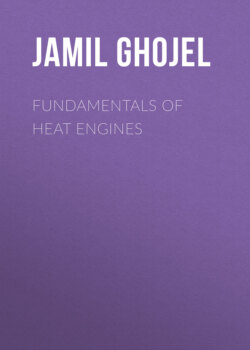Читать книгу Fundamentals of Heat Engines - Jamil Ghojel - Страница 62
1.3.8.1 Thermodynamic Scale of Temperature
ОглавлениеTemperature is a fundamental concept, not expressible in terms of other units or physical properties of the devices used to measure temperature, such as alcohol or mercury in glass thermometers or the electromotive force generated in a thermocouple. Physicists have established that temperature measures the kinetic energy of molecules, and the higher the molecular agitation, the higher the temperature and vice versa. The physicist William Thomson (Lord Kelvin) is credited with the establishment in 1848 of the absolute temperature scale (hence the symbol K for temperature) on the basis of Carnot's reversible cycle.
To show how it is possible to arrive at an absolute scale, a hypothetical experiment can be conducted to show that an absolute zero of temperature must exist, and then extend this line of reasoning to develop an ‘energy’ or ‘thermodynamic’ temperature scale.
It was shown earlier that the efficiency of the Carnot cycle is written as
This equation shows that TL can never be zero or less than zero, for if TL were equal to zero, the thermal efficiency of the heat engine would be 1, or 100%, which would be a violation of the second law. Also, if TL were less than zero, the thermal efficiency would be greater than 100%, which would mean a reversal of the direction of QL, and heat would be drawn from the low‐temperature source. This also would be a violation of the second law. So, theoretically, the absolute zero of temperature could never be reached.
If a Carnot engine is operated between a high‐temperature source at the temperature of boiling water TH and a low‐temperature sink at the temperature of melting ice TL, and the amount of heat received Qsteam and rejected Qice were measurable accurately, the ratio Qsteam/Qice would be equal to 1.3662. Since Qsteam/Qice = Tsteam/Tice,
(1.90)
If the temperature range Tsteam − Tice is arbitrarily divided into 100 equal divisions (call it 100 °C), a second equation can be obtained
(1.91)
The simultaneous solution of Eqs. (1.90) and (1.91) yields the temperature of boiling water and melting ice on a thermodynamic scale:
If the temperature range Tsteam − Tice is divided into 180 equal divisions (call it degrees Fahrenheit, F), we get
(1.92)
The determination of a thermodynamic scale using reversible Carnot engine as described here is practically impossible. To determine where the number 1.3662 comes from, we start with the equation of state for a perfect gas at constant volume and constant pressure, which yields
(1.93)
Next, constant‐volume and constant‐pressure thermometers are placed alternately in boiling water and melting ice, and the volume and pressure ratios of the gases in the devices (carbon dioxide CO2, hydrogen H2, and helium He) are measured at an initial pressure. If the procedure is repeated for different initial pressures and the results plotted versus pressure, straight lines are obtained, which converge at zero absolute pressure to a value of 1.3662, which must be the ratio of absolute temperature of boiling water and melting ice.
Currently, the international temperature scale (ITS‐90) is the standard used to represent the thermodynamic (absolute) temperature scale as closely as possible with improved accuracy over gas thermometry.
